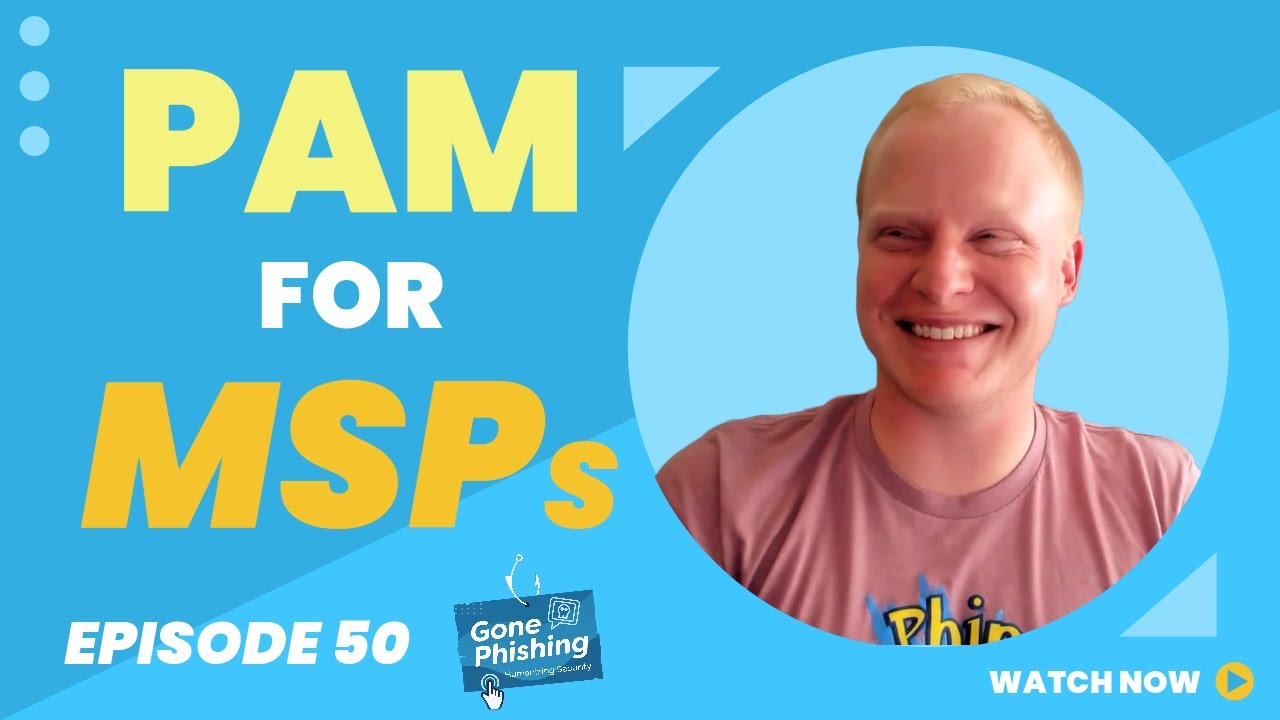


Transcript:
Connor Swalm:
Welcome to Gone phishing, a show diving into the cybersecurity threats that surround our highly connected lives. Every human is different. Every person has unique vulnerabilities that expose them to potentially successful social engineering. On this show, we'll discuss human vulnerability and how it relates to unique individuals. I'm Connor Swam, CEO of Phin Security, and welcome to Gone Phishing.
Hey everyone, it is Connor, CEO at Phin and host of the Gone Phishing podcast. And today we're going to talk about how MSPs, the people that we all know and love, and the people that Phin and I want to serve greatly, are always looking for more ways to. Provide additional value to their clients. But more often than not, when they try to do that with a security. Vendor or an IT vendor of some sort, they end up choosing one that isn't MSP friendly. And I'm going to talk about why I see that happening from a lot of the folks and the friends that I've talked with and stories that I've heard from other industry professionals as well.
So first and foremost, what does it mean to be MSP friendly? Right? Everyone can say, every tool that you. Work with can say that they're MSP. Friendly, but that doesn't necessarily mean that their tool is focused on driving a specific outcome. It doesn't mean that they are focused. On helping you serve SMB clients or. Midsize clients as well.
So typically when you're evaluating a vendor, there's really two main focuses that they have. They usually have one or the other. They're either incredibly enterprise focused, so they'll build a tool that is incredibly customizable, that can be kind of stitched into the fabric of the companies and the enterprises that they're serving. And then the other is MSP focused. I. E. It's going to need to. Work with an IT service provider to serve potentially hundreds of clients at a time.
And while that may not sound like an incredible difference, what ends up being built into both of those different products as a result of those focuses can. Turn into a large feature set difference. That can help an MSP drive a way better outcome in their clients and more importantly, spending way less time on it. So of those of you that are. Listening that are already msps or in the MSP industry, a lot of this. Is going to sound like stuff that you already know and you've heard, but. We'Re going to kind of walk through. It a bit for those that are listening that aren't quite aware of the MSP industry. So the first, probably the biggest feature that an Emmett, quote, unquote, I'm air quoting. For those of you that are listening.
The biggest one they'll mention is a concept called multitenancy. And it's basically where as opposed to. Logging into a dashboard, like, let's say your banking dashboard online and. Getting access to only your accounts, if. Your tool is multitenant, you can log in and have access to hundreds if not thousands. I'm just using a random number here. All of the accounts that you've set up. So basically you get to provision, that is, create new instances of this tool that you are working with, and you get one single dashboard, one single account. To manage, to not only get access, but to provision, to delete, to edit, to look at reports, to do a. Whole lot of account management stuff to all of those accounts at one time. And that's multitenancy. So that's pretty much the main one is all the time we're asked by msps, do we have a multitenant dashboard? The answer is yes.
But even though some folks say they're multitenant, there's some other features as well that you should definitely look into if you're looking for an MSP friendly tool. Second is a super easy to understand. And easy to implement. Both of those are really important billing structure. So whether that is a bill for. All of the aggregate usage of all the tenants, or flat fee per tenant or flat fee per month, unlimited tenants. Unlimited usage, whatever the model is, it. Needs to be simple to understand and simple to implement. It doesn't quite matter what it is. In terms of what the final billing structure looks like. It just matters that it's very easy for you to understand what your costs. Are going to be, and as a. Result, you can pass those on properly to your clients. When you start getting into a spot where you don't know exactly what you'll. Be charged in a given month for. Either the usage or for the licensing. Fee of a tool.
That's when that can start to encroach on your margins. You can start to lose margin in. Certain areas or bill your clients improperly. And then have to settle that up. At some other point in the future. So it creates a mess when it's. Not easy to understand and easy to implement. I've seen tools have vastly different billing. Structures and billing methods, and like I said, as long as it's easy to. Understand and implement, it's usually a smooth process to go through, smooth integration with that vendor.
Third is monthly invoicing, monthly options. The worst thing in the world, not. Only for me, but also for the. Partners that I work with and the people that I'd like to serve and. That Phin would like to serve, is that when you pay upfront for a. Service and then you don't use it. As much as you expected, and as. A result, you waste all of those licenses you purchased, or you waste all. Of that usage that you purchased, and. You just get into a spot where you're either billing, one of two things is happening. You're either billing your client for services. They didn't receive, or you are eating. That margin for them and you're paying. For the services that you never used on their behalf. And so if you don't have monthly options for invoicing or for account styles. Then it's just rife for opportunity for.
You to overestimate or underestimate your usage and then as a result, get stuck. In a tricky situation with your clients. The fourth is having month to month agreement options. The worst thing in the world is. When you think a tool is going to be perfect for your use case. You do all of the best due. Diligence that you possibly could. You do as much research as you can. Maybe there's a trial, maybe there's not, and then you get into a year. Long or multi year agreement. Turns out this tool isn't really a good fit for you or your clients. Or maybe some of your clients have. Different needs by the time you get. Around to implementing it, and then you're. Stuck holding that contract and holding that. Payment for the rest of that contract term.
So basically. Those are all of the business side things. A lot of it has to do with invoicing and making sure it's flexible. Enough for folks to take advantage of properly and to implement on their own timeline on the product side of things as well. I'll sum it up. Basically, your product should not have to. Be babysat if it's MSP friendly. So if you're looking at a tool and you're going to have one of. Your technicians or your account managers or anyone log into this product continuously over and over again to fiddle with things or to reset things up, if you can't just set it up. And forget about it, in most cases.
It'S probably not going to be a tool that scales really well with your business. We talked about this on a previous episode. The main thing that an MSP should. Be concerned with in a lot of cases is how much can they automate out of their day? How much of these consistent, simple and. Repetitive and relatable tasks can just be handled by using better software or setting. Software up in a more convenient way. So those are just some of the features. Never babysit a dashboard again, or not. Having to babysit a dashboard that can. Look 100 different ways in terms of.
The automations that a tool could say they have, or maybe they can demonstrate. That they have, such as automated reporting. Being able to set up a list. Of people per tenant in that dashboard. That are going to get some kind of report on a consistent basis so. You don't have to log in and. Then download and then email and then. Converse with your client and go get more reports. Just being able to add a list and send it out is really helpful to a lot of folks. Not only that we serve, but a. Lot of folks in the MSP industry. So with all that being said, there's. A few places that I see current. Providers failing msps, and I see that impacting their day to day life.
The first and foremost way that I see current providers failing msps is all around automated reporting. Now, I'll caveat it with this reporting is incredibly hard. Getting a PDF to look a certain way is difficult, let alone getting a. PDF and a set of CSVs and. A set of data to be displayed. In such a way that almost every single one of your clients that you. Work with is going to like it. It's near impossible, right? So this is already an impossible task that an MSP friendly tool should be trying to automate. But I see a lot of area. For improvement here, which is a lot of msps. What they'll end up having to do. Is they will take the report, the canned report, out of a platform. They'll end up interpreting that either in. Their own systems that they've built or another tool that they use, and then they will present that to the client. In a different way. And that process of pulling data in. One platform, pulling data out of a. Platform, putting it into another, reconfiguring the data there, making the report look a little differently, and then having to have. A conversation with the client, that takes. An incredible amount of time and almost always requires way more than just your account manager.
It'll require a tech who has access to a tool. If you're provisioning access to only certain. People in your organization to have access tools, then you have to get that person involved. So it just can become a whole mess. And this ends up leading to people. Needing having way more things on their plate than they should. Every time the first of the month. Comes around, or the end of the month comes around. Whenever you're doing reporting, that person might. Have to block off their calendar and. End up working with you or working with a lot of their clients in order to get all that done. That's really one of the main areas. And like I said at the very. Beginning, automated reporting is already an impossible task. Making something presentable to everyone is incredibly. Difficult, but it's just where I would like to see not only us improve. In a certain way, but also the. Industry improve in a lot.
So that leads me to kind of a set of questions that you should. Be willing to have a candid conversation with a provider or a vendor you're. Trying to work with before you add a tool to your stack. First and foremost, is this a multitenant solution? Most often every vendor you work with. Is going to say yes. There are a few ways where you. Can kind of pay lip service to multitenant architecture without actually having to build it as a core piece of your platform. So there are a couple of other.
Questions you could ask there, such as, can I actually see the dashboard? Can you verify that you're not logging in and out of separate clients, that you log in with one master access, you can delegate access to other people's accounts effectively as well, and that you. Can provision and report on your entire. Tenancy at a time or individual tenants at a time. Those are the main features. And like I said, if you can. Log in, get a demo or whatever. And see that usually you're good to go, or if they answer yes to. All those questions and then actually make. Good on it, you're pretty good. The second piece that you should always. Ask is upfront, flat out. What are the contract terms? You should always read every contract you're. Going to end up signing. However, you can get a really good idea of if this partnership is completely. Lopsided to begin with, or if it's straight down the middle, it's 50 and it's a really good opportunity for everyone involved.
Some questions you should ask are what are the contract terms? Do I get discounts for committing to higher usages that I know I'll have? Can we create a rollout schedule that'll up the bill gradually as opposed to. Turning it on right away? Can we opt into longer agreements at. A later date to get discounts? Can we do monthly invoicing? Do we have to pay upfront? How is the billing structured? Are there any upcharges in the app. Itself or in the tool itself that I'm going to want to purchase potentially, that I'm not seeing right here on this pricing sheet.
One of the worst things in the world is to have a tool that. You know you can use. You budget in a certain price, you. Put it in your clients managed services agreement, so you're making your margin, and then you get in the tool and. You realize you need to buy a premium. I'm air quoting again for those of you listening. But you'd realize you have to buy a premium feature. You've just doubled your tool cost, and. Now all of a sudden you're underwater. On offering that tool in your stack. As opposed to making whatever margin you. Were going to bake into that for. Your clients anyway for your services.
So those are just like some of. The things you should ask. Obviously, if you're spending time talking with an account rep or an account manager at this vendor, you can ask a lot more questions that are all centered. Around whatever's going to work for your business. A lot of msps are a disparate field. Just to give an example, some msps. Have a defined stack that's opt in, opt out. You either are a client with a. Full stack or you're not. Others are still breakfix where, hey, what. Services would you like? Let's create a cookie cutter solution for you that really works for you and. Your people and your organization. So depending upon your business needs and. How you'd like to operate and how. You'D like to create manage services for. Your clients, and it also depends on. The market you're serving, like the locality you're in. You're going to want to ask different. Questions, but the bigger ones are all. Centered around how are you billing and invoicing me? And the second is, can I just have a single dashboard where I can do a base set of features that are reporting access all accounts, delegate access. To other people if I'd like. And then also look at all of.
The invoicing that's going on and make sure that it's commensurate with what we agreed to. So those are just some of the. Things that you should do. Again, a lot of umsps who are. Listening to this already know of these. I just figured I would rehash them for all the folks that are listening. And maybe for you, because these are. A lot of the questions that we get here at Phin . And then also that I would honestly. Prefer that a lot of our partners would ask before they end know jumping. Into bed with us as a result of we want them to know that. They'Ve evaluated every tool properly, and that's. Exactly what I would like to see all of my MSP friends do, is. Just evaluate everything properly, make sure it. Works for your business.
So that is essentially the rapid fire skill set or questions to ask if you're looking for an MSP tool, what it's going to mean, what it's going to look like. And once again, I am Connor, CEO of Phin and the host of the Gone Fishing podcast. Thank you so much for listening and I will see you next time.
Thanks so much for tuning in to gone phishing. If you want to find out more about high quality security awareness training campaigns, how to launch them in ways that actually engage employees to change their habits, then check us out Phin Security at phinsec.io. That's P-H-I-N-S-E-C IO or click all of the wonderful links in our show notes. Thanks for fishing with me today and we'll see you next time.






